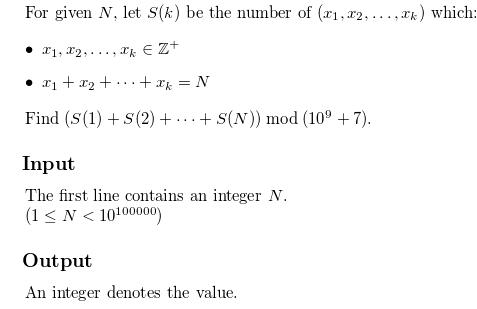Sum

Simple Input
2
3
Simple Output
2
4
思路:原题把人坑死,原来交换位置算新的一种.插板法 C(1,n)+C(2,n)+······+C(n,n) = 2^n.
即求2^(n-1),但是n极大,这里取模运算就用到了大数取模和费马小定理.
假如a,p互质,则a^(p-1)%p == 1恒成立,所以此题是不是可以利用这一性质呢.
因为2^n %p== 2^(p-1)*2(n-(p-1))%p == 2^(p-1)%p*2(n-(p-1))%p == 1*2(n-(p-1))%p.
所以此题我们只要计算n%(p-1)就好,n这么大怎么模p-1呢?
1234%m == (((1*10+2)*10+3)*10+4 )%m == (((1%m*10+2)%m*10+3)%m*10+4)%m
解决啦!
代码:
#include<bits/stdc++.h>
#define mem(a,b) memset(a,b,sizeof(a))
#define mod 1000000007
using namespace std;
typedef long long ll;
const int maxn = 1e6+5;
const double esp = 1e-7;
const int ff = 0x3f3f3f3f;
map<int,int>::iterator it;
char s[maxn];
ll big_mod()
{
ll ans = s[0] - '0';
int len = strlen(s);
for(int i = 1;i< len;i++)
ans = (ans*10+s[i]-'0')%(mod-1);
return ans;
}
ll quick_pow(ll x,ll y)
{
ll ans = 1;
while(y)
{
if(y&1)
ans = (ans*x)%mod;
y>>= 1;
x = (x*x)%mod;
}
return ans;
}
int main()
{
while(~scanf(" %s",s))
{
ll m = big_mod();
cout<<quick_pow(2,m-1)<<endl;
}
return 0;
}